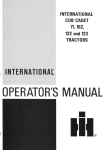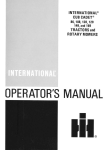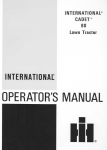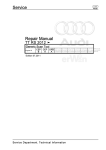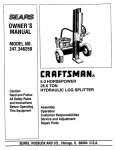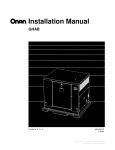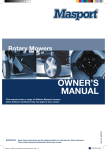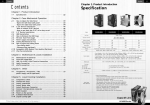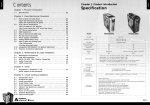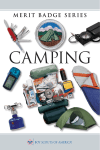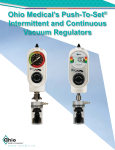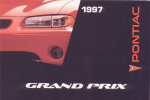Download Cub Cadet 7530 Lawn Mower User Manual
Transcript
LE FT and RIG HT indicate the left and right sides of the riding mower when facing forward in the driver's seat. The portion of the machine which carries the operator is referred to as the RIDER. The housing under the rider, which does the cutting, is referred to as the MOWER. The entire machine is referred to as a RIDING MOWER. 2 This symbol is used to call your attention to instructions concerning your personal safety. Be sure to observe and follow these instructions. Whenever the operator dismounts from the riding mower or leaves the riding mower unattended,disengage the mower and shut off the engine. Know the controls and how to stop quickly. READ THE OPERATOR'S has been supposedly cleared of foreign objects, small objects may have been overlooked and may be discharged by the mower causing serious injury. MANUAL. C.nly move the gear selector lever to shift into gear or change gears with the clutch-brake pedal disengaged. Never place hands or feet under the mower, in the discharge chute, or near any moving parts while the mower is running. Do not work on the mower with the engine running, as the mower could acciden- Watch out for roadways. traffic when crossing or near When making any adjustments to your riding mower, always disconnect the high tension wire to the spark plug, otherwise the engine may start causing serious injury. tally be engaged and cause injury. Never leave the engine running unattended or permit the riding mower to be operated by persons not acquainted with its use and the rules for safe operation. Be sure the mower clutch control is "DISENGAGED" and the transmission is in neutral before starting the engine. Be sure all stones, branches, or other objects that might be picked up and thrown by the mower blades are removed before starting to mow. It is recommended that the machine be stopped and inspected for damage after striking a foreign object and that any damage be repaired before restarting and operating the machine, as broken pieces could be thrown causing injury. Never look into the discharge opening while the blades are in motion as serious accident and/or injury could result. Until you become familiar with the riding mower it is recommended that quick starts, stops, and rapid engagement of the mower be avoided. . Stay alert for holes in terrain and other hidden hazards which could cause loss of control or upset. Keep the machine in good operating condition and keep safety devises in place. Use guards or shields as instructed in Operator's Manual to avoid injury. Children should not be allowed to operate the riding mower unless properly supervised, and are physically and mentally capable of safe operation or injury may occur. The discharge shield on the mower must be attached at all times while operating the mower. Avoid sudden stops or starts, especially on steep slopes to avoid injury. Disengage power to the mower when transporting or not in use. Do not carry passengers or give rides as serious injury could result. Before backing the riding mower always look for obstacles or bystanders in the area where the riding mower will move. No one should operate this machine while under the influence of intoxicants or drugs that impair the sensesor reactions. Do not allow anyone in the area parallel to the discharge opening while moving. Although the area 3 Handle gasoline with care it is highly flammable: A. Use approved gasoline container. B. Never remove the fuel tank cap or fill the fuel tank when the engine is running, is hot, or indoors. Also, do not smoke when working around inflammable fuel. Wipe up spilled gasoline. C. Replace gasoline cap securely. NOTE: system mower position The rider has an interlock safety starting and the engine will not start unless the clutch control is in the full disengaged and the gear selector lever is in neutral. After the engine starts, slowly move the throttle control lever to "FAST" position. Do not use the choke to enrich the fuel mixture, except when starting the engine. STARTING THE ENGINE Keep hands and feet clear of blade and all moving parts to avoid injury. Observe the following 1. Place clutch-brake the procedure pedal Pedal to start theengine: The combination clutch-brake pedal is used to disengage the engine from the transmission when shifting gears and to actuate the brake to stop therider. in the lockedposition. To shift gears while the rider is in motion, pedal should be depressed approximately 1/2 the travel distance. Be sure the spark plug wire is properly attachedto the spark plug. Make certain mower clutch position as shown. Be sure gear selector lever is in the"DISENGAGED" To disengage the clutch, and apply the brake, press the pedal all the way down. lever is in "NEUTRAL". 5. Move the throttle control to choke position. Electric Starting: Turn ignition key clockwise to the start position and release it as soon as the engine starts. Do not operate the starter more than 30 seconds at anyone time. If engine does not start within this time, turn the key off and wait a few minutes, then try again. STOPPING THE ENGINE Electric and Manual Starting (Equipped with Ignition Key): Depress the clutch-brake pedal to disengage the transmission. Move the gear selector lever to "NEUTRAL" and the mower clutch control lever to the "DISENGAGE" position. After the engine starts, slowly move the throttle control lever to the "FAST" position. Do not use the choke to enrich fuel mixture, except when necessary to start the engine. Move the throttle control lever to the "SLOW" position and allow the engine to idle a short time before stopping. Then turn the ignition key or switch to the "OFF" position. Manual Starting (Riding mowers without electric starting:) If so equipped, turn ignition key clockwise to the "ON" position. Give a quick steady pull on the recoil starter handle to start the engine. Do not jerk or pull it out to the very end in a I:ough manner. Always pull the handle so the rope is in a straight line through the guide. Maintain your hold on the handle and allow the cord to return slowly. Releasing the handle when the cable is extended will shorten the life of the starter. Clutch-Brake 2. 3. 4. Manual Starting (Not equipped with Ignition Key): Depress the clutch-brake pedal to disengage the transmission. Move the gear selector lever to "NEUTRAL" and the mower clutch control lever to the "DISENGAGE" position. Move the throttle control lever to the "OFF" position. 6- ADJUSTINGAND OPERATING 8e sure blade~ are assembled so the cutting edges are in the direction of rotation with the wind wings pointed toward the deck. Position the mower in the lowest position. Detach front of mower from frame by removing the retaining pins from the front mounting brackets. The pins are held by two quick-attachable cotter pins. To detach the blade, place a large wood block between cutting edge and housing to keep the blade from rotating. Then remove the jam nut or cap screws, depending on whether you have a side discharge or a rear discharge mower. Slide the mower backward mower center drive pulley of mower from I ift frame. When replacing blades use the reverse procedure, lexcept put the wood block between the wing of the blade and the deck. to remove V-belt from and to disconnect rear Raise the mower lift handle to the highest position and slide the mower out to the side. HEIGHT OF CUT Cutting height can be adjusted from approximately 1-1/2-i nches to 4-i nches qu ick Iy and easiIy. The mower height control lever is located directly under the operator's seat. When the lever is pulled out it can be raised or lowered to the desired cutting height. The height of cut is approximate since operator weight and tire inflation will effect the cutting height. The cutting blades are designed to create a suction to I ift the grass for an even cut. The mower extends beyond the driving wheels to permit cutting close to walkways, fences, buildings, trees, etc. ATTACHING AND DETACHING THE MOWER The facilitate changing the blades, sharpening the blades, cleaning, etc., the mower may be detached as follows: CAUTION! Stop the engine and disconnect the high tension wire to the spark plug. Lock the brake prior to leveling the mower. 9- ADJUSTINGAND OPERATING ADJUSTING MOWER DRIVE V-BEL T Raise the mower to the maximum lift position and turn the wheels a full right and full left. If thecle between the mower housing and the tires is less than 1/8-inch, the mower shou Id be moved back slightly to give clearance. adjust the mower proceed as follows: CAUTION! Stop the engine, disconnect the high tension wire to the spark plug, and lock the brake before working on the machine. REPLACING 1. Place the mower height control lowest position. lever in the MOWER DRIVE V-BELT CAUTION! Stop the engine, disconnect the high tension wire to the spark plug, and lock the brake before working on the machine. Engagethe mower clutch. Put a pencil line on the mower housing in front of the mower front mounting brackets. Adjust the mower forward by loosening bolts "c" on the front mounting brackets and sliding the mower forward until the distance between the backsides of the belt is 1-1/2-inch at "D". NOTE: Substitute belts may not be satisfactory. Use only specified replacements. See your International Harvester dealer. Place the mower height control lever in the lowest position and disengage the mower clutch control. NOTE: The mowe. should be moved forward an equal distance on cach side (approximately 1/4-inch), Detach the front of the mower from the lift assembly to facilitate removal of the belt from the mower-crankshaft pulley and the mower drivepull Retighten bolts "C". installing a new belt be sure to place belt in Reconnect the high tension wire to the sparkplug.the upper groove of the mower drive pulley (on the deck) and in the crankshaft pulley. 7. Place the mower lift handle in the third position from the bottom. Start the engine and slowly engage the mower clutch control. Then, disengage and check to make sure mower declutches properly. If mower clutch control does not declutch, shut off the engine, detach the spark plug wire, and check position of belt guides See page 14. If it still will not declutch, move mower backward 1/16inch. 8. To 2. 3. 4. 5. When 6. lower groove of the mower- NOTE: When installing a new belt, make certain that the belt runs between the pulleys and the belt guides on the mower drive pulley and the mowercrankshaft pulley. Otherwise a ruined belt will result, thus requiring early replacement. 12- ADJUSTINGAND OPERATING MAIN DRIVE BELTS 1 -Main drive belt 2 -Safety starting switch 3 -Mower clutch control 4 -Oil drain hole 5 -Mower drive belt idler 6 -Clutch-brake pedal return spring 7 -Transmission drive idler 8 -Transmission brake rod assembly 9 -Drive chain 10 -Crankshaft -mower drive pulley 11 -Transmission drive pulley Underside of riding mower with mower removed to show mower drive belt, pulleys, rear axle drive chain, etc. NOTE II A II -Period ically check the transm ission end of the rod to obtain the proper adjustment of 1-1/2-inches. Tighten the nuts relative to each other until firmly locked together to insure that they will not loosen up. brake rod spring. If the spring length exceeds 1-1/2-inches with the brake pedal in the locked position readjust the locknut and jam nut on the -13- ADJUSTINGAND OPERATING ADJUSTABLE A REAR AXLE DRIVE CHAIN To properly adjust the drive chain set the transmission in neutral, block the front wheels, jack up the rear end of the rider, and remove the rear wheels. NOTE: Remember the order in which the washers are removed from the axle. When reassembling be sure the washers are assembled in the same order to maintain proper drive chainalig CAUTION! Stop the engine, disconnect the high tension wire to the spark plug, and lock the brake before working on the machine. After 5 hours of operation, or when excessive noise is noted, check the chain tension. The drive chain can be adjusted to compensate for stretch and wear. The rear axle bearing mounting holes are slotted at the top to move the axle back for proper adjustment as shown. A Be sure machine to avoid injury. is adequately Adjust the bearing housings until the slack is out of the chain. The chain must not be taut. If the drive chain is too tight, excessive wear and stretch will result in premature failure. Not enough tension may allow chain to jump the sprocket, ride the teeth, break, or whip excessively. Axle must be perpendicular to side of rear frame. Adjust each side an equal amount. Tighten nuts to 33-37 ft.-lbs. blocked -16- This engine is designed to operate on unleaded or low lead gasoline with a 91 minimum octane rating (Research Method), The use of unleaded gasoline will lengthen spark plug and valve life, maintain engine performance longer, and reduce rust and corrosion of engine while stored. A CAUTION! Handle gasoline with care, it is highly flammable: A. Use approved gasoline container. B. Never remove the fuel tank cap or fill the fuel tank when the engine is running, is hot, or indoors. Also, do not smoke when working around flammable fuel. Wipe up spilled gasoline. C. Replace fuel tank cap securely. CARBURETOR 1 -Carbu retor 2 -Fuel shut-off ADJUSTMENTS The carbu retor is adjusted at the factory. Do not make adjustments unless absolutely necessary. Factory settings are correct for normal operating conditions. If adjustments are necessary proceed as follows: A CAUTION! the engine During in operating confined do area not such run as storage building any longer than is necessary for immediate moving of the machine ouside into the air. Exhaust gases are toxic. Opening doors and windows may not provide adequate ventilation. Start the engine and allow it to warm up at 3000 RPM. Turn needle valve in until engine misses (lean mixture) then turn it out past smooth operating point until engine runs unevenly (rich mixture). Turn needle valve to the mid-point between rich and lean so engine runs smoothly. Hold throttle at idle position and set idle speed, adjusting screw until engine idle speed is 1800 RPM. Hold throttle at idle position and turn idle valve in (lean) and out (rich) until engine idles smoothly. If necessary, correct idle speed. Release the throttle -engine should accelerate without hesitation or sputtering. If engine does not accelerate properly, the carburetor should be readjusted, usually to a slightly richer mixture of needle valve. 1 -Needle valve 2 -Idle valve 3 -Idle speed adjusting screw -17- The battery is located under the operator's seat. To service or replace the battery remove the seat. Remove the wing nut located under the center backrest of the seat. Lift the back of the seat and pull back to remove seat from front slot of seat mounting bracket. Occasionally remove the battery cables and brighten the terminal contact surfaces with wire wool, and reassemble. Apply a light coat of vaseline or chassis lubricant. Be sure terminals are clamped tightly, the rubber cover is slid over the positive terminal, and that battery is fastened securely in the battery box. Replace defective cable, and keep vent holes in battery filler caps open. When reinstalling operator's seat reverse the above procedu reo The output of the built in charging circuit in the engine rises from 2 amperes at 2400 RPM to 3 amperes at 3600 RPM and uses less than .2 A CAUTION! If the tractor is to be tipped up or on its side remove the batteries to avoid spilling the electrolyte. Battery electrolyte is poisonous and can be injurious to eyes, skin, and clothing. If electrolyte is spilled, flush immediately with a solution of one part baking soda to four parts water. horsepower. Connecting Booster Batteries When required, a booster 12-volt battery may be connected in parallel with the 12-volt system on the tractor. NOTE: All circuits must be turned "off", Electrical System is Negative (-) grounded only, Reversed polarity will result in permanent damage to components of the electrical system. A BATTERY For long battery life and trouble-free operation check the battery at 15-day intervals for water level. If the battery is in need of charging, it should be given immediate attention. Keeping the battery fully charged not only adds to its life but makes it available for instant use when needed. solutions, Electrical storage inflammable batteries hydrogen gas see your SPARK PLUG NOTE: Remove before removing. CAUTION! Acid or electrolyte should never be added except by a skilled battery man. Under no circumstances "dopes", highly For dependable battery service, International Harvester dealer. The electrolyte (acid and water) in each cell should be at the proper level at all times to prevent battery failure. When the electrolyte is below this level, pure, distilled water should be added. add any special battery powders. ION! off when charging and continue to do so for some time after receiving a steady charge. Do not under any circumstances allow an electric spark or an open flame near the battery. Do not lay tools across battery terminals as this may result in a spark or short circuit which may cause an explosion. Be careful to avoid spilling any electrolyte on hands or clothing. Liquid Level A CAUT give or -18- all dirt from base of spark plug ELECTRICALSYSTEM Remove the spark plug after every 100 hours of operation for cleaning and checking the gap. When adjusting the gap, always bend the outer electrode. Never bend the insulator. If gap between the electrodes is too great, the engine will misifre and be hard to start. NOTE: Do not use abrasive cleaning machine; because any grit introduced into the engine could cause severe damage. Always use a spark plug wrench when removing or reinstalling the plug. Be sure the gasket is in good condition, and screw plug in tightly. Do not tighten more than enough to compress the gasket to seat the plug and assure a good heat transfer between the plug and cylinder head. Replace defective plug with new plug. Use a Champion CJ-8 spark plug or equivalent. See your International Harvester dealer for a correct replacement plug. Cleaning Spark Plug Clean spark plug with a pen knife or wire brush and solvent. If electrode is burned away or the porcelain is cracked, replace with new plug. ENGINE COOLING This is an air cooled engine. Air must circulate freely around the engine. Keep the cooling fins and housing area free of accumulated dirt and trash or engine will overheat and result in damage to moving parts. OIL FOAM AIR CLEANER Clean and re-oil the air cleaner element every 25 hours under normal operating conditions. Under extremely dusty conditions, clean the element every few hours. Checking the spark plug gap. Set gap at .O30-inch. Remove the cover screws, lift the air cleaner cover and carefully remove the element to prevent dirt from entering the carburetor. Wash the foam element in kerosene or liquid detergent and water to remove all dirt. Also clean the air cleaner body and cover. Wrap the foam element in a cloth and squeeze dry. Then, saturate the element in engine oil (SAE-30). Squeeze the element to remove excess oil and reassemble and fasten to carburetor with screw. NOTE: Replace air cleaner mounting gaskets that are worn or damaged, to prevent dirt or dust entering engine through improper sealing. To clean the element, proceed as follows: 19- At the end of the mowing season or in the event the riding mower is to be stored for any length of time, (30 days or more) proceed as follows: Drain the fuel tank and run the engine until the fuel is exhausted from the fuel system. Drain the fuel tank out-ofdoors and into a clean container. CAUTION! Handle gasoline with care, it is highly flammable. A. Use approved gasoline container. B. Never remove the fuel tank cap or fill the fuel tank when the engine is running, is hot, or incloors. Also, do not smoke when working around flammable fuel. Wipe up spilled gasoline. C. Replace fuel tank cap securely. A CAUTION! the engine During in operating confined do area not such run as storage building any longer than is necessary for immediate moving of the machine ouside into the air. Exhaust gases are toxic. Opening doors and windows may not provide adequate ventilation. CAUTION! If the tractor is to be tipped up remove the battery to avoid spilling the electrolyte. Battery electrolyte is poisonous and can be injurious to eyes, skin, and clothing. If electrolyte is spilled, flush immediately with a solution of one part baking soda and four parts water. Remove spark plug and pour one ounce of I. H. No. 1@ Engine Oil through spark plug hole into thecylind Crank engine several times to distribute oil over cylinder walls. Replace the spark plug. Wash or clean and completely lubricate the riding mower. See "lubrication Guide" on pages 23 and 24. This is a fiberglass body. Use only a mild soap or detergent. Do not use ammonia base or abrasive cleansers. Remove the battery and place it in a cool, dry place above freezing (+320 F.). Check the battery at least once a month for water level and amount of charge. Store your riding mower in a dry and protectedplace Leaving the riding mower outdoors, exposed to the elements, will result in materially shortening its life. automotive type steering wheel is detachable. By removing the roll pin at the lower end of thesteering shaft the steering wheel can be removedfrom the housing. See "A" in illust. This feature provides for easier storage or transporting in areas where height is a factor. CAUTION! The 20- ENGINE Oil NOTE: After checking the oil the oil dip stick must be fully seated in the filler tube to avoid excessive oil consumption and irregular engine operation. To aid starting, the selection of crankcase lubricating oils should be based on the lowest anticipated temperature until the next drainperiod. After the first five hours of operation, change the oil as directed in Lubrication Table. The engine oil must be drained and replaced with new oil every 25 hours of engine operation thereafter, or a minimum of once a year, and sooner if the equipment is operated under extremely dusty conditions. Check the oil level of the engine crankcase every five hours to see that it is filled to the correct level. Check the oil level only while the engine is stopped. The crankcase oil filler cap has the oil level gauge attached to it. Always keep the oil level between the "FULL" and "ADD" marks in the "SAFE" range on the gauge. Do not over-fill. When checking the oil level, the gauge must be withdrawn and wiped clean, then inserted all the way and withdrawn for a true reading. recommend I.H. No.1 Engine Oil. If other than I.H. No.1 Engine Oil is used, it must be designated "For Service MS". In new API code these oils are usually designed as meeting either SO or SE requ irements. We 1. 2. 3. 4. 5. After Every 5 Hours of Operation Oil filter cap and Bayonet-type Oil Level Gauge See Page5. Check the oil (with the engine stopped) and add sufficient new oil to bring it to the "FU LL" mark on the gauge. Do not \ over-fil'. Do not operate the engine if the oil level is below the "ADD" mark on the gauge. Dip stick must be fully seated , before operating the engine. After Every 10 Hours of Operation Rear Axle Drive Chain See Page 16. Pedal Return Spring SeePage13. Mower Idler Pulley Arm See Page 15. Rear Axle Bearings (2) See Page 16. f Apply a light coat of engine oil to the full length of the chain. Apply a few drops of oil to the spring. Apply a few drops of oil to the idler pulley arm. Use IH 251 H EP grease or equivalent No.2 multi-purpose lithium grease and apply two or three strokes of the lubricator to grease fittings. -21- LUBRICATION GUIDE Afer Every 10 Hours of Operation -Continued Front Wheels Use IH 251 H EP grease or equivalent No.2 multi-purpose lithium grease and apply one or two strokes of the lubricator to the grease fittings (one fitting on each front wheel). Mower Spindle Bearings (3) Rear Discharge Mower See Page 15. Use IH 251 H EP grease or equivalent No.2 multi-purpose lithium grease and apply one or two strokes of the lubricator to the grease fittings (one fitting on each spindle). Center spindle can be greased through lift handle slot. After Every 25 Hours of Operation While the engine is warm remove the drain plug and drain all the oil from the crankcase. To drain completely, raise the right side of the riding mower by placing a 4-inch to 6-inch block under the right rear wheel. After draining, replace the drain plug. Remove the crankcase oil filler cap and refill the crankcase with new oil up to the "FU LL" mark on the oil level gauge. Refer to the "Lubrication Table" for proper quantity and viscosity to use. Engine Crankcase See Page 13. Mower Spindle Bearings (3) Side Discharge Mower See Page 15. Use IH 251H EP grease or equivalent No.2 multi-purpose , lithium grease and apply one or two strokes of the lubricator to the grease fittings (one fitting on each spindle). Center spindle , can be greased through lift handle slot. Check Point of Lubrication at Hours Change Anticipated Hours +320 F. 32 oz. Crankcase 5 25 qt. Transmission and Differential 6. 7. 8. 9. Above Engine 1 Air Temperature at +320 to 00 F. I. H. No.1 @ I.H. No.1 (!) Engine Oil SAE-30 Engine Oil SAE-10W Below SAE-5Wor SAE-5W-20 Factory sealed. See your ,. H. Dealer 22- 00 F. with No accident-prevention program can be suc- industrial plant, can be safer than the man who cessful without the wholehearted co-operation is at the controls. of the person who is directly responsible for the vented-and operation of equipment. done by the operators who accept a full measure To read accident reports from allover the If accidents are to be pre- they can be prevented-it will be of their responsibility. country is to be convinced that a large number It is true that the designer, the manufacturer, of accidents can be prevented only by the the safety engineer can help; and they will help, operator anticipating but their combined efforts can be wiped out by the result before the accident is caused and doing something about a single careless act of the operator. it. It is said that' 'the best kind of a safety device is a careful operator. II We ask you No power-driven equipment, whether it be transportation or processing, whether it be on the highway, in the harvest field or in the be to be that kind of an operator.































